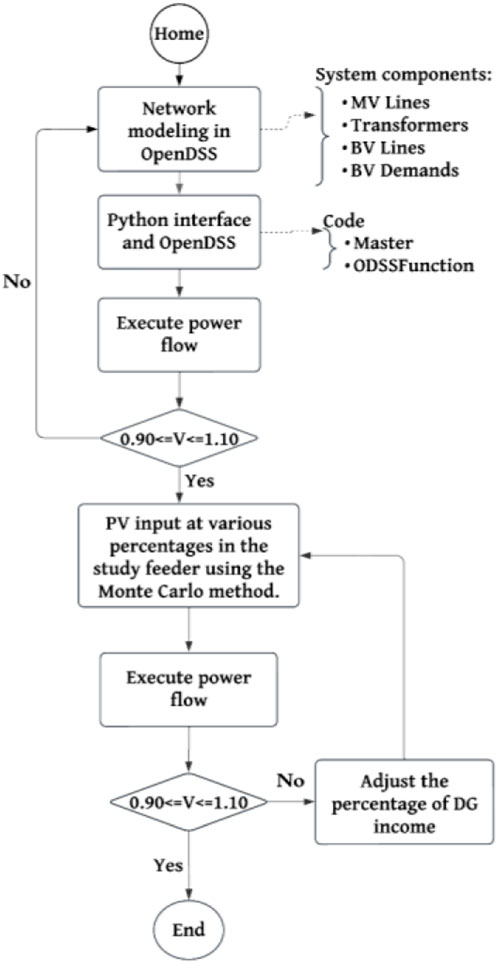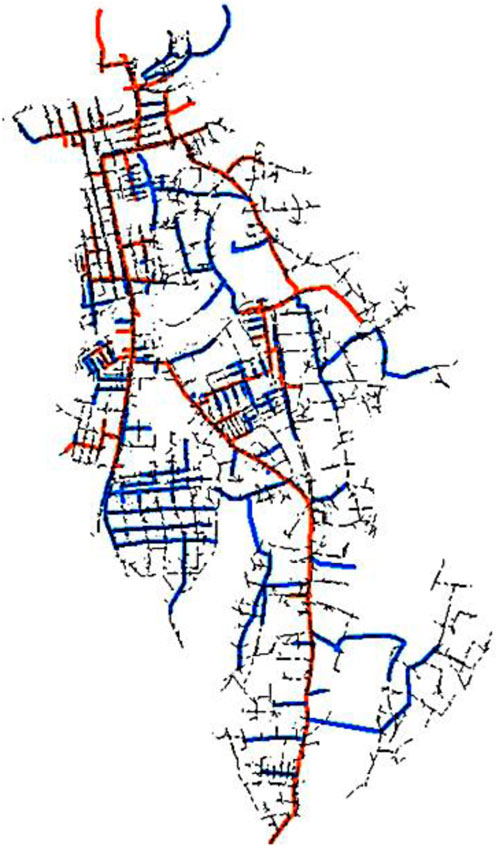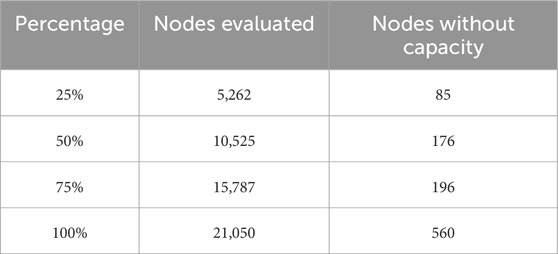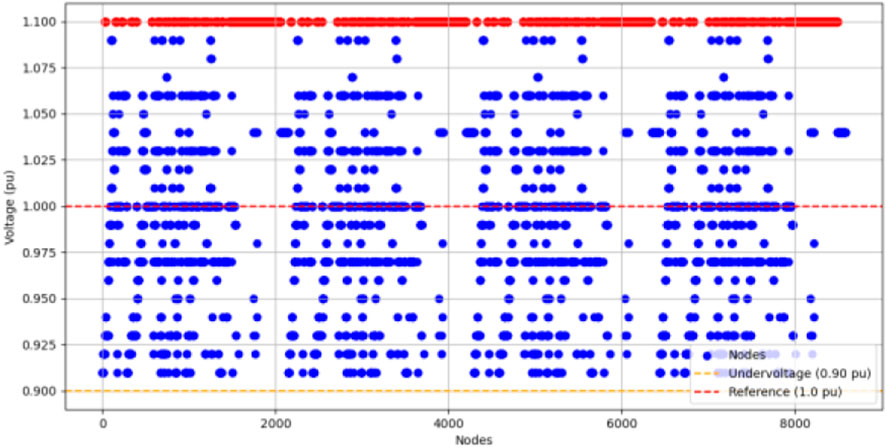- Engineering and Applied Sciences Faculty (CIYA), Electrical Engineering, Technical University of Cotopaxi, Latacunga, Ecuador
Electric distribution systems currently present a marked interest in solving problems related to technical losses, overloading of lines and being able to assimilate the increase in energy demand. Therefore, the objective of this research was to analyze the behavior of a network in the presence of distributed generation, taking into account the efficiency in operations, stability and compliance with the established technical standards. The problem studied is related to the inefficiency present in some systems to incorporate distributed generation and cover the demand in certain sectors, in the presence of overloads, increased costs and reliability losses. The methodology used in the research considers power flow, equivalent circuit modeling and computational simulations to evaluate the behavior of the network in different scenarios. The results show a favorable balance of loads at the nodes, thus achieving a more efficient use of existing assets and enhancing the planning of transmission routes. This research demonstrates the importance of incorporating DG and its technical feasibility in 75% of all nodes in the case studied, thus promoting energy sustainability, emphasizing the importance of implementing these strategies to ensure a reliable, efficient and scalable supply with an important contribution to the sustainable development of electricity systems in contexts of high demand and limited resources in distribution networks.
1 Introduction
Distributed generation (DG), close to consumption centers, promotes efficient self-consumption (Touzani et al., 2021), and transforms the centralized energy model of the 20th century, allowing a bidirectional flow of energy between users and the grid. Faced with the environmental impact of fossil fuels, responsible for climate change due to carbon dioxide emissions (Benalcázar et al., 2020), non-conventional renewable energies and DG gain global relevance. This approach uses small installations (less than 10 MW) integrated to the electricity system, adapted to their location, power, voltage and supply characteristics, offering greater versatility than centralized plants.
Globally and regionally, local renewable generation models with collective ownership and active social dimension are emerging (Parker, 2018), as a response to the climate crisis. States and international organizations promote agreements, roadmaps, strategic plans and regulatory standards to move towards a sustainable energy model. In the 21st century, Tandil drives the energy transition through self-consumption projects and sustainable solutions (Nogar et al., 2024), promoting photovoltaic energy for consumption and contribution to the grid. In addition, it implements solar plants, parking meters, educational devices and ecological points, making these innovative systems visible in the community.
Solar panel cleaning is a challenge in the PV industry. In Khadka et al. (2020), they propose the use of data science and machine learning to optimize this process, going beyond traditional visual inspection. The authors suggest a decision-making model based on probabilistic parameters and data processing techniques. On the other hand, Dadi Riskiono et al. (2021) present a success case in SDN 4 Mesuji Timur schools, where school solar panel systems (SSPS) ensure the continuity of educational activities, even in case of power outages. These systems, composed of solar cells connected in series, parallel or mixed, enhance the availability of electricity in schools.
In Hwang and Sánchez (2024), it is noted that the Ecuadorian industrial sector is expanding, which increases the demand for electricity. This study sized a photovoltaic system and proposed a design, emphasizing the return on investment through the savings generated.
The author of Cuenca et al. (2023), suggests DG in urban areas such as Guaranda, evaluating solar energy systems for businesses. They highlight energy savings and return on investment, although they admit challenges in medium voltage grids due to high demand and capacity.
In Ecuador, the segmentation of residential consumers is fundamental to identify DG opportunities. A study proposed by Quijano et al. (2017), shows that high consumption users obtain greater profitability with DG systems, facilitating market segmentation. DG, especially solar, is key to reducing environmental impact in urban areas. Technological advances have lowered the costs of photovoltaic and storage systems, promoting their adoption. In Ecuador, regulation ARCERNNR 008/23 (Arcernnr, 2023), provides a solid regulatory framework for DG implementation, guaranteeing its technical and financial feasibility.
The objective of this article is to evaluate the technical feasibility of distributed generation for self-consumption in urban circuits, analyzing its impact on energy efficiency, grid stability and sustainability, in order to improve the quality of electricity supply and reduce maintenance costs. Ecuador faces a generation deficit, exacerbated by climate change-related water source challenges and limited studies on distributed generation’s impact. This increases the risk of voltage fluctuations, overloads, and imbalances, compromising electricity service quality and underscoring the importance of self-consumption as a viable solution.
2 Materials and methods
Self-consumption DG in urban circuits seeks to integrate small-scale renewable systems, such as solar panels in homes, businesses and companies. The research used a quantitative methodology based on Research Method (Caldas, 2003), which offers a systematic approach to collect, examine and interpret data. In the first stage, a literature review of scientific publications and official documentation was conducted, allowing to obtain secondary information on public and private strategies, the actors involved and the status and evolution of experiences on the subject.
In Hassan et al. (2019), demonstrates a DEAL model that incorporates differentiated privacy in blockchain-founded microgrid energy auctions, safeguarding user information. It employs a consortium to decrease computational burden and boost traders’ revenue while preserving efficiency and social welfare in decentralized energy trading.
In the proposal Shuvra and Chowdhury (2019), active and reactive power regulation is carried out in the inverter of each PV panel through a nonlinear optimization model due to the particularities of the grid. The reactive power regulation can be performed with a constant or invariant power factor, although the reactive power/voltage method is more efficient than the typical power factor method (Hossain et al., 2023). The proposed model includes equations that define its operating area, restricting the additional reactive power flow and active power losses in the network. The objective function in Equation 1 optimizes active power injection and reduces reactive power during simulation T (time). Equations 2–5 describe the injection and nodal balance, with demands modeled as polynomials of impedance, current and constant power. Equations 6–10 detail the inverter parameters and voltage limits per node, ensuring stability, safety and efficiency.
where:
In this model,
2.1 Mathematical model of hosting capacity (HC)
Hosting Capacity (HC) measures how much distributed generation can be integrated into a grid at a specific node and time without compromising security, quality, reliability or requiring infrastructure investment (Walla, 2012). Optimization is essential in the face of increasing photovoltaic energy, employing different methods to manage electrical distribution networks, considering technology, costs, grid codes and congestion, where Equation 11 maximizes distributed generation capacity:
where
The current or voltage constraints come from Equations 12–14 of the power flow:
where
2.2 Generator model (PVSystem)
For the simulation of the system, the photovoltaic (PV) power generator available in OpenDSS (PVSystem) that operates based on its internal parameters was considered (Muhtar and Mustika, 2017), where the power P is determined based on the irradiance, temperature and the rated power Ppmp (considering a temperature of 25°C and an irradiance of 1.0 kW/m2). Subsequently, the inverter efficiency, operating voltage and power factor are influenced to determine the output power which are expressed with Equations 15, 16.
This system has internally incorporated the inverter and the variables it considers are:
- Irradiance: Net irradiance after application of the load shape factor.
- Ppmp (kW): Maximum rated power of the panel that is influenced by irradiance and temperature.
- P-TFactor: Factor added to the power-temperature curve.
- Efficiency: Inverter efficiency factor.
The increase in photovoltaic generation reduces emissions and technical losses in the grid (Mary et al., 2012), but its massification poses technical challenges. Studies such as the one by Rubinstein and Kroese (2016) stochastically analyze, using the Monte Carlo method, the maximum power capacity allocated to the grid when incorporating solar panels per user. The methodology, detailed in Figure 1, uses OpenDSS to model primary and secondary lines, transformers and demand, being key to evaluate the integration of panels in the electrical distribution network.
The methodology uses the Python-OpenDSS interface as shown in Figure 1, to model the network in the Master.dss file and define properties in ODSSfunction (Hariri et al., 2017). From the system modeling, the power flow is calculated and, if the voltages do not violate the values, they are corrected in OpenDSS, verifying a range of ±10%. Photovoltaic generation injection is simulated by placing different percentages of panels on the feeder. If voltage limits are exceeded, variables such as nodes, currents and overvoltages are analyzed, determining how many PV resources can be integrated without compromising stability and safety.
Before evaluating the case study, the simulation tool was validated using the IEEE 13-bus system solved in Tounsi et al. (2022), which incorporates user generators. Node voltages and line currents were evaluated after each simulation, considering the operational limits. The study was divided into two stages: first, the system was simulated without DG and then DG was implemented in randomly selected user groups using the Monte Carlo method, where:
2.3 Stage 1. simulation of the base case study without DG
Here, a feeder of the city of Latacunga without the incorporation of DG is established as a case study, where the network is simulated to evaluate the voltages and currents, which will be solved in the subroutine of analysis of results, these data obtained are used as a reference point for further analysis.
2.4 Stage 2. incorporation of DG to the network
In this section, the insertion of distributed generation in different percentages depending on the number of available nodes is carried out using N Monte Carlo cases. This method identifies the loads and distributes the DG in all load nodes with the same characteristics according to the exposed method and uses the per unit values to evaluate the voltages.
For the DG in the simulation, it was considered that each PV panel can generate 450 W in a space of 2.40 m2, and taking into account that homes have an average space of 85 m2, then each user could install about 40 PV panels, representing an injection of 18 kW of power.
3 Results
The analysis of the hosting capacity in distribution networks seeks to determine the admissible DG injection level without altering the electrical parameters of the system. The validation was performed by simulating the IEEE 13 nodes feeder test in Schneider et al. (2018), applicable to networks in Ecuador. The results obtained in the reference taken showed a voltage error of 8% and load error of 5%, confirming that the algorithm and the designed tool are accurate and suitable for the feeder analysis to be studied.
The electrical system studied, illustrated in Figure 2, details the feeder where the medium voltage lines, essential for efficient transport over long distances, and low voltage lines for residential, commercial and industrial use are shown. A comprehensive view is presented using data from the south of the city of Latacunga, Ecuador. It covers transmission, transformation and related loads, allowing to analyze the relationship between distributed generation, efficiency, reliability and energy balance.
The feeder characteristics present 37.76 km in medium voltage lines, having 325 transformers, with 21,050 nodes, in 118.97 km of low voltage lines for a total of 6,600 low voltage users, standing out for its supply capacity and scope. These data reflect the magnitude and complexity of the electrical system in this area.
3.1 Stage 1. simulation of the base case study without DG
According to Ecuador’s regulations, voltages in the electrical distribution networks may vary ±10% with respect to the nominal voltage of 13.8 kV. Without DG, the voltages at the nodes comply with the regulations during the day. This methodology is useful for analyzing the integration of PV generation, ensuring that the established limits are not exceeded. The feeder, modeled with 21,050 nodes using a ZIP polynomial model, showed that no node presents unacceptable conditions for DG incorporation.
3.2 Stage 2. incorporation of DG to the network
The results obtained by analyzing the simulated scenarios mentioned in the second stage of the study. The selection nodes were defined using the Monte Carlo method, applying it in multiple iterations to ensure randomness in the selection of the nodes, performed for the DG insertion levels.
Table 1 analyzes the incorporation of DG in increasing percentages, evaluating 5,262 nodes at 25% DG, with 85 nodes out of regulation. At 50%, 10,525 nodes are examined, of which 176 exceed the limits. At 75%, 15,787 nodes have capacity, but 196 exceed the voltage threshold. At 100%, 21,050 nodes are evaluated, with 560 presenting overvoltages outside the allowed range ±10%. This reveals unacceptable fluctuations and highlights that 100% DG compromises stability. Although nodes with capacity increase linearly, problems also grow, highlighting the need to strengthen the network.
Figure 3 presents the p.u. voltage mapping of the network nodes for the N Monte Carlo cases evaluated, defining the operational limits between 0.90 and 1.10 p.u. Based on the simulated scenarios, it is noted that several nodes show violations at the upper voltage limit, which points to overvoltage problems in some areas of the system. By examining the entire simulated system at 100%, a careful count of the incidents of these violations is carried out, where it is verified that there are 560 critical nodes, where the voltage exceeds the admissible levels and this underlines the importance of modifying the voltage control to enhance the stability of the network.
This result is relevant for the country, as the increase in residential self-consumption generators requires analysis of PV penetration. The findings indicate that with more self-consumption systems, changes in the grid and DG regulations will be necessary. Above certain penetration levels, infrastructure investments and increased voltage control will be required. This will allow the grid to adapt to the growing demand for renewable energy.
The DG simulation confirms results consistent with Pinargote et al. (2021), demonstrating technical feasibility in local grids, especially in the residential sector, with an acceptance limit of 57%. However, at 100% PV input, overloads and regulatory violations are detected. According to Figure 3, during the day, voltages exceed ±10%, generating fluctuations, reverse flows and higher fault currents. Thus, the optimum DG limit in the analyzed feeder is 75%, according to the levels assigned to the evaluated nodes.
The analysis of load ability at the nodes, considering stability and supply quality factors, reveals that DG implementation is not feasible at all nodes due to feeder overloads and constraints. This gradual approach allows improving load distribution and anticipating optimal conditions for future DG scenarios. It is suggested to apply optimization techniques as in Zeraati et al. (2018), to identify optimal injection points and, in addition, to perform a technical-economic analysis in regulated customers with linear programming as proposed in Paredes et al. (2024) to evaluate the feasibility of micro-generation.
4 Conclusion
In order to validate the analysis of the power supply in the feeder, simulation with OpenDSS and a Python interface was used, dividing the study into two phases to integrate the DG to the electrical system. The simulations revealed voltage drops in the network, which allowed identifying critical points with a regulation range of ±10%. From this, PV generation was progressively injected at the nodes, determining the maximum feeder hosting capacity.
The research tested the integration of DG in an electrical network, evaluating nodes with penetrations of 25%, 50%, 75% and 100%. A gradual growth of evaluated nodes was observed, from 5,262 to 21,050 nodes with 100% insertion capacity, together with an increase of nodes without capacity, reaching 560 at 100%. This evidences structural limitations in the network that affect its stability, underlining the need to strategically plan the injection points to optimize efficiency, supply quality and move towards sustainable energy.
The analysis performed corroborates the feasibility of integrating photovoltaic generation into the feeder during the planning and design phases of distribution networks. The results indicate that the optimal integration limit is 75%, meeting power quality criteria and guaranteeing system stability. This highlights the potential of distributed generation to improve the sustainability of power grids. As a next step, it is crucial to investigate methods to identify and optimize system nodes, maximizing benefits without compromising operability and considering economic aspects.
Data availability statement
The original contributions presented in the study are included in the article/Supplementary Material, further inquiries can be directed to the corresponding author.
Author contributions
DC: Conceptualization, Data curation, Formal Analysis, Funding acquisition, Investigation, Methodology, Project administration, Resources, Software, Supervision, Validation, Visualization, Writing – original draft. SM: Data curation, Funding acquisition, Supervision, Writing – review and editing. CQ: Data curation, Formal Analysis, Software, Validation, Writing – review and editing. ML: Conceptualization, Funding acquisition, Resources, Writing – review and editing.
Funding
The author(s) declare that no financial support was received for the research and/or publication of this article.
Conflict of interest
The authors declare that the research was conducted in the absence of any commercial or financial relationships that could be construed as a potential conflict of interest.
Generative AI statement
The author(s) declare that no Generative AI was used in the creation of this manuscript.
Publisher’s note
All claims expressed in this article are solely those of the authors and do not necessarily represent those of their affiliated organizations, or those of the publisher, the editors and the reviewers. Any product that may be evaluated in this article, or claim that may be made by its manufacturer, is not guaranteed or endorsed by the publisher.
Supplementary material
The Supplementary Material for this article can be found online at: https://www.frontiersin.org/articles/10.3389/fenrg.2025.1542501/full#supplementary-material
References
ARCERNNR (2023). Regulation No. ARCERNNR-008/23. Available online at: https://www.controlrecursosyenergia.gob.ec/wp-content/uploads/downloads/2023/11/Regulacion-Nro.-ARCERNNR-008-23-signed1.pdf.
Benalcázar, P., Lara, J., and Samper, M. (2020). Distributed photovoltaic generation in Ecuador: economic analysis and incentives mechanisms. IEEE Lat. Am. Trans. 18 (03), 564–572. doi:10.1109/TLA.2020.9082728
Caldas, M. (2003). Research design: qualitative, quantitative, and mixed methods approaches. Rev. Adm. Contemp. 7 (1), 223. doi:10.1590/S1415-65552003000100015
Cuenca, A., Oña, C., Suquillo, I., and Miniguano, H. (2023). Design methodology of off-grid PV solar powered systems for rural areas in Ecuador. Rev. Técnica “Energía 20 (1), 43–51. doi:10.37116/revistaenergia.v20.n1.2023.537
Dadi Riskiono, S., Oktaviani, L., and Mulya Sari, F. (2021). Implementation of the school solar panel system to support the availability of electricity supply at sdn 4 mesuji timur. IJISCS Int. J. Inf. Syst. Comput. Sci. 5, 34. doi:10.56327/ijiscs.v5i1.960Available online at: https://api.semanticscholar.org/CorpusID:233254703.
Hariri, A., Newaz, A., and Faruque, M. O. (2017). Open-source python-OpenDSS interface for hybrid simulation of PV impact studies. IET Generation, Transm. and Distribution 11 (12), 3125–3133. doi:10.1049/iet-gtd.2016.1572
Hassan, M., Rehmani, M., and Chen, J. (2019). DEAL: differentially private auction for blockchain based microgrids energy trading. IEEE Trans. Serv. Comput. 1. doi:10.1109/TSC.2019.2947471
Hossain, Md. S., Abboodi Madlool, N., Al-Fatlawi, A. W., and El Haj Assad, M. (2023). High penetration of solar photovoltaic structure on the grid system disruption: an overview of technology advancement. Sustainability 15 (2), 1174. doi:10.3390/su15021174
Hwang, Y., and Sánchez, Á. (2024). Renewable energy transition and green growth nexus in Latin America. Renew. Sustain. Energy Rev. 198, 114431. doi:10.1016/j.rser.2024.114431
Khadka, N., Bista, A., Adhikari, B., Shrestha, A., Bista, D., and Adhikary, B. (2020). Current practices of solar photovoltaic panel cleaning system and future prospects of machine learning implementation. IEEE Access 8, 135948–135962. doi:10.1109/ACCESS.2020.3011553
Mary, A. C., Cain, B., and O’Neill, R. (2012). History of optimal power flow and formulations. Fed. Energy Regul. Comm. 1, 1–36.
Muhtar, A., Mustika, I., and Suharyanto, (2017). “The comparison of ANN-BP and ANN-PSO as learning algorithm to track MPP in PVSystem,” in 2017 7th international annual engineering seminar (InAES), 1–6. doi:10.1109/INAES.2017.8068573
Nogar, L., Clementi, L., and Jacinto, G. (2024). Experiencias innovadoras para la transición energética: El caso de Tandil, Argentina. Bol. De. ESTUD. GEOGRÁFICO 121, 121–140. doi:10.48162/rev.40.044
Paredes, D., Marrero, S., and Quinatoa, C. (2024). Optimization of investments in photovoltaic microgeneration for self-consumption with grid injection. Nanotechnol. Perceptions 20 (Issue S14), 2023–2038. doi:10.62441/nano-ntp.vi.3065Available online at: www.nano-ntp.com.
Parker, C. (2018). Energy Transition in South America: elite’s views in the mining sector, four cases under study. Ambiente and Sociedade 21 (0). doi:10.1590/1809-4422asoc0089r1vu18l1ao
Pinargote, D., Sornoza, G., Pérez, A., and Gámez, M. (2021). The distributed generation and its regulation in Ecuador. Braz. J. Bus. 3 (3), 2018–2031. doi:10.34140/bjbv3n3-001
Quijano, D., Wang, J., Sarker, M., and Padilha, A. (2017). Stochastic assessment of distributed generation hosting capacity and energy efficiency in active distribution networks. IET Generation, Transm. and Distribution 11 (18), 4617–4625. doi:10.1049/iet-gtd.2017.0557
Rubinstein, R. Y., and Kroese, D. P. (2016). Simulation and the Monte Carlo method. Wiley. doi:10.1002/9781118631980
Schneider, K., Mather, B., Pal, B., Ten, C., Shirek, G., Zhu, H., et al. (2018). Analytic considerations and design basis for the IEEE distribution test feeders. IEEE Trans. Power Syst. 33 (3), 3181–3188. doi:10.1109/TPWRS.2017.2760011
Shuvra, M., and Chowdhury, B. (2019). Distributed dynamic grid support using smart PV inverters during unbalanced grid faults. IET Renew. Power Gener. 13 (4), 598–608. doi:10.1049/iet-rpg.2018.5761
Tounsi, W., Saulo, M., and Ngoo, L. (2022). Controlled electric vehicle charging for reverse power flow correction in the distribution network with high photovoltaic penetration: case of an expanded IEEE 13 node test network. Heliyon 8 (3), e09058. doi:10.1016/j.heliyon.2022.e09058
Touzani, S., Prakash, A. K., Wang, Z., Agarwal, S., Pritoni, M., Kiran, M., et al. (2021). Controlling distributed energy resources via deep reinforcement learning for load flexibility and energy efficiency. Appl. Energy 304, 117733. doi:10.1016/j.apenergy.2021.117733
Walla, T. (2012). Hosting capacity for photovoltaics in Swedish distribution grids. Available online at: https://api.semanticscholar.org/CorpusID:107740746.
Zeraati, M., Golshan, M., and Guerrero, J. (2018). Distributed control of battery energy storage systems for voltage regulation in distribution networks with high PV penetration. IEEE Trans. Smart Grid 9, 3582–3593. doi:10.1109/tsg.2016.2636217Available online at: https://api.semanticscholar.org/CorpusID:3575506.
Keywords: distributed generation, self-consumption, overload, photovoltaic panel, renewable energy, electrical system
Citation: Cordova D, Marrero S, Quinatoa C and Leon M (2025) Prospects for distributed self-consumption generation in urban circuits with the use of photovoltaic systems. Front. Energy Res. 13:1542501. doi: 10.3389/fenrg.2025.1542501
Received: 09 December 2024; Accepted: 11 April 2025;
Published: 28 April 2025.
Edited by:
Leonardo Micheli, Sapienza University of Rome, ItalyReviewed by:
Sujal Bhavsar, Other, United StatesMário Gomes, Polytechnic Institute of Tomar (IPT), Portugal
Copyright © 2025 Cordova, Marrero, Quinatoa and Leon. This is an open-access article distributed under the terms of the Creative Commons Attribution License (CC BY). The use, distribution or reproduction in other forums is permitted, provided the original author(s) and the copyright owner(s) are credited and that the original publication in this journal is cited, in accordance with accepted academic practice. No use, distribution or reproduction is permitted which does not comply with these terms.
*Correspondence: Diego Cordova, ZGllZ28uY29yZG92YTQ3OTlAdXRjLmVkdS5lYw==
 Diego Cordova
Diego Cordova Secundino Marrero
Secundino Marrero Carlos Quinatoa
Carlos Quinatoa


